Hospital waste management
Hospital acquired infections come from health care wastes, so we need to understand and practice its management.
Share Presentation
Embed Code
Link
Download Presentation
- waste
- infectious waste
- healthcare waste
- waste storage
- healthcare waste management
- leaking infectious waste bags

rivinus + Follow
Download Presentation
Hospital waste management
An Image/Link below is provided (as is) to download presentation Download Policy: Content on the Website is provided to you AS IS for your information and personal use and may not be sold / licensed / shared on other websites without getting consent from its author. Content is provided to you AS IS for your information and personal use only. Download presentation by click this link. While downloading, if for some reason you are not able to download a presentation, the publisher may have deleted the file from their server. During download, if you can't get a presentation, the file might be deleted by the publisher.
Presentation Transcript
- Session 15:Hospital Waste and Hazardous Material Instructor: Mr.Lazaro, Rivinus
- Learning objectives By the end of this session, students are expected to be able to: • Describe the management of health care wastes and hazardous materials • Explain the handling techniques and disposal methods of health care wastes • Explain the methods of disposing of a dead human body
- Plan of presentation • Definitions • Situation of hospital waste in Tanzania • Categories of hospital wastes • Health care management system • Handling of hospital care wastes • Treatment and disposal of health care wastes • Methods of disposing of human dead body
- Definitions Wasteisalmostanythingthathasserveditsoriginalintendedpurposeandisbeingdiscardedorstoredpriortobeingdiscarded. Healthcare(Hospital)wasteincludesallthewastegeneratedbyhealth-careestablishments,researchfacilities,andlaboratories. TASK: Mention few you know…………….
- Introduction: HCW in Tanzania. • The management of healthcare waste is of great importance to the welfare of the people and country at large due to its potential environmental hazards and public health risks. • Tanzania like other developing countries faces the problem of healthcare waste management (HCWM).
- Introduction: HCW in Tanzania. The Ministry of Health and Social Welfare (2007) estimated that, • Annual generation rate for hospital is around 0.41 kg/occupied bed/day. • And that for HC and dispensaries is estimated to be 0.03 kg/patient/day • The challenge is that Most of the HCW generated is not properly managed especially when it comes to waste segregation, collection, storage and disposal or treatment.
- Categories of hospital wastes • Hospitalwastesarecategorizedaccordingtotheirweight,densityandconstituents. • TheWorldHealthOrganization(WHO)hasclassifiedmedicalwasteintodifferentcategories.Theseare:
- Categories of hospital wastes • Infectious:material-containingpathogensinsufficientconcentrationsorquantitiesthat,ifexposed,cancausediseasese.g.laboratorycultures;wastefromisolationwards;tissues(swabs),materials,orequipmentthathavebeenincontactwithinfectedpatientsexcreta. • Sharps:disposableneedles,syringes,infusionsets,saws,blades,brokenglasses,nailsoranyotheritemthatcouldcauseacut. • Pathological:tissues,organs,bodyparts,humanflesh,fetuses,bloodandbodyfluids;
- Categories of hospital wastes • Pharmaceuticals:drugsandchemicalsthatarereturnedfromwards,spilled,outdated,contaminated,orarenolongerrequired(bottles,boxes). • Chemicalwaste:wastecontainingchemicalsubstancese.g.laboratoryreagents;filmdeveloper;disinfectantsthatareexpiredornolongerneeded;solvents • Pressurizedcontainers:Gascylinders;gascartridges;aerosolcans;
- Categories of hospital wastes • Radioactive:solids,liquidsandgaseouswastecontaminatedwithradioactivesubstancesusedindiagnosisandtreatmentofdiseasese.g.unusedliquidsfromradiotherapyorlaboratoryresearch;contaminatedglassware,packages,orabsorbentpaper; • Wasteswithhighcontentofheavymetals:batteries;brokenthermometers;blood-pressuregauges;etc. • Others:wastefromtheoffices,kitchens,rooms,includingbedlinen,utensils,paper,etc.
- Sources of HCW • Medicalwards:mainlyinfectiouswastesuchasdressings,bandages,stickingplaster,gloves,disposablemedicalitems,usedhypodermicneedlesandintravenoussets,bodyfluidsandexcreta,contaminatedpackaging,andmealscraps. • Operatingtheatresandsurgicalwards:mainlyanatomicalwastesuchastissues,organs,fetuses,andbodyparts,otherinfectiouswaste,andsharps.
- Sources of HCW • Relatedlaboratoriesandresearchcenters • Medicalandbiomedicallaboratories • Biotechnologylaboratoriesandinstitutions • Medicalresearchcenters • MortuaryandautopsycentersAnimalresearchandtesting • Bloodbanksandbloodcollectionservices • Nursinghomesfortheelderly
- Management of Hospital wastes • Health care waste (HCW) management includes all activities involved in handling, transportation, storage, pre-treatment, final treatment and disposal of waste. • Healthcare waste management also addresses waste minimization aspects, including good housekeeping.
- Steps in Healthcare Waste Management • Waste classification/survey • Waste segregation • Waste minimization • Handling and collection • On-site transport and storage • Off –site transportation • Treatment and disposal
- Waste survey • Wastesurveyisanimportantcomponentofthewastemanagementscheme.Asurveyhelpsinevaluationboththetypeandquantityofwastegeneratedinhospitals. And help to determine means of their disposal
- Waste segregation • Segregationreferstothebasicseparationofdifferentcategoriesofwastegeneratedatsourceandtherebyreducingtherisksaswellascostofhandlinganddisposal. • Segregationisthemostcrucialstepin healthcare wastemanagement. • Segregate wastes from each other beginning at the point of generation, and maintaining the separation during storage and transport, until treatment
- Sample of an Educational Segregation Poster
- Waste segregation • Check the problems with waste segregation in the picture below……….
- What is wrong with this picture? • A lot of waste that is segregated as “infectious” Photo shows sterile packaging in infectious (red) bag. It also includes sharps which should be in sharps containers. • y be clean • Sterile packaging, uncontaminated gloves and masks, and other clean waste should be treated as general waste WHAT IS WRONG WITH THIS PICTURE?
- Problems of Segregation-what is wrong? WHAT IS WRONG WITH THIS PICTURE? • Sharps waste should not be discarded in Photo shows sharps in infectious (yellow) bag. Sharps should be in sharps containers. • on-sharps containers • Infectious waste should not be discarded with general waste
- What is Wrong With This Picture? Black bag wrongly used for general waste (drinking cups, food scraps, discarded food packaging, paper, empty blister pack, empty food wrapper) and for sharps waste (syringes). This photo was taken in a country with the following color code: Yellow = infectious waste; Black = discarded medicines, cytotoxic and chemical waste
- What is Wrong With This Picture? Black bag wrongly used for general waste (empty water bottle, packaging, discarded cloth) and also for infectious waste (bloody bandages, contaminated gloves). This photo was taken in a country with the following color code: Yellow = infectious waste; Black = discarded medicines, cytotoxic and chemical waste
- What is Wrong With This Picture? Black bag wrongly used for infectious waste (bloody bandages), sharps waste (syringes, presumably the needle from the intravenous (IV) set), and general waste egbanana and lemon peels This photo was taken in a country with the following color code: Yellow = infectious waste; Black = discarded medicines, cytotoxic and chemical waste
- What is Wrong With This Picture? General waste (sterile packaging) discarded in the infectious waste bag. Sharps discarded in the infectious waste bag. This photo was taken in a country with the following color code: Yellow = infectious waste
- Problem of Overfilling and Mixing Colors WHAT IS WRONG WITH THIS PICTURE? Red bag is overfilled. It is placed inside a black bag (probably because of leaks). Leaking infectious waste bags should be put in bags with the infectious waste color. This photo was taken in a country with the following color code: Red = infectious waste, Black = general waste
- WasteMinimization • it includesthefollowing: • Sourcereduction:measuressuchaspurchasingrestrictionstoensuretheselectionofmethodsorsuppliesgeneratelesshazardouswaste. • Recyclableproducts:useofmaterialsthatmayberecycled,eitheron-siteoroff-site. • Goodmanagementandcontrolpractices:applyparticularlytothepurchaseanduseof
- Waste collection • Wastesshouldnotbeallowedtoaccumulateatthepointofproduction • Nobagsshouldberemovedunlesstheyarelabeledwiththeirpointofproduction(hospitalandwardordepartment)andcontents • Asupplyoffreshcollectionbagsorcontainersshouldbereadilyavailableatalllocationswherewasteisproduced
- Waste collection • •Thecollectionof healthcare wasteinvolvesuseofdifferenttypesofcontainer. • Thecontainers/binsshouldbeplacedinsuchawaythat100%collectionis • achieved. • Sharpsmustalwaysbekeptinpuncture-proofcontainerstoavoidinjuriesandinfectiontotheworkershandlingthem.
- Waste storage • Astoragelocationforhealth-carewasteshouldbedesignatedinsidethehealth-careestablishment. • Thewastesshouldbestoredinaseparatearea,room,orbuildingofasizeappropriatetothequantitiesofwasteproducedandthefrequencyofcollection. • Each waste shall be stored in receptacles corresponding to its coded colour
- Waste storage- storage Bins
- Infectious Waste Containers • Ideal infectious waste containers are those that have • Lids that remain closed except when waste is discarded • Pedal-operated devices to open the lids • Color-coded bags inside the containers
- Waste storage: Minimum Requirements for Waste Bins and Receptacles • Be leak-proof with well fitted lid • Made of non-corrosive material (reusable polypropylene bins) • Disinfected and washable after each use • Lined with colour-coded non-PVC plastic (disposable polyethylene liner-begs) • Portable (fixed with handle ) • Receptacles and lining for radioactive waste shall be made of material which prevents emission of radiation • safety boxes are used for keeping sharps, usually 5 litres
- Healthcare waste transportation • On- site waste transportation is done using a designated trolley or wheelbarrow and shall be marked HCW.
- specifications for the wheelbarrow • Easy to push • Shall not be used for any other purposes • Have smooth surfaces, leak proof, made of plastic or metal • Easy to load and unload
- Healthcare waste transportation • Off-site waste shall be removed using designated vehicles for transportation of HCW.
- Vehicles should have the following features • Sealed body with lockable compartment doors • Marked with appropriate hazards symbols • Lifting equipment • Be equipped with features to secure bins during transportation • Be rigid, leak proof and easy to clean • The vehicle must be cleaned and disinfected at the end of each working day. Use Sodium hypochlorite
- Treatment and disposal (a) on site treatment/disposal This is done at the health facility. See methods which are being applied………
- 1. Burning Pit • Width should be 1 to 2 metres • Pits shall be dug 1-2 metres wide and to depth of 2-5 metres, but at least 1.5 metres above the water table • The pit shall be fenced and located away from public areas
- 2. Burying • Burying is placing waste into a pit and covering it with earth. • When the level of waste reaches to within 30 to 50 metres of the surface of the ground, fill the pit with soil and dig another pit • Expired vaccines shall be encapsulated and buried, and not burned
- 3. Incineration • high temperature in burning waste (starting at 800°C). • reduces the volume of the waste and eliminates pathogens. • Recommended health facility incinerator is De Montfort Incinerator (Mark 111) Model.
- WastesSuitableForIncineration • Lowheatingvalue:above2000kcal/kg(8370kJ/kg) • Combustiblematterabove60%. • Non-combustiblesolidsbelow5%. • Moisturebelow30%.
- Wastetypesnottobeincinerated • Pressurizedcontainers;Explosionmayoccurandcausedamagetotheequipment. • Halogenatedplastics(e.g.PolyVinylCarbon)releasegasesthatcontainhydrogenchlorideandmaycontaindioxins.eg bottle cap • Wasteswithhighcontentofheavymetals(e.g.thermometers,batteries).Incinerationwillcauseemissionoftoxicmetals(e.g.lead,cadmium,mercury)intotheatmosphere. • Radioactivewaste:treatmentdoesnotaffectradioactivepropertiesandmaydisperseradiation. Eg X-ray or photographic materials
- Disposal of human dead body Everyoneisafraidofdeadbodies Disposal of the dead is the process of getting rid of corpse in a sanitary manner
- Disposal methods • There are many methods of disposing of the dead • These methods vary among the tribes in our country • The methods used are intimately connected with religious beliefs, superstitions and sentiments • It is important to consider these religious beliefs, superstitions and sentiments when planning for disposal of the dead
- Disposalofdeadisdonebyvariousmethods 1.Incineration 2.Burial 3.Watersubmersion 4.Cannibalism 5.Bodydonation 6.Bodyworlddisplay 7.Lefttobeeatenawaybyvultures/Arielburial 8.Hydrolysis/dissolution
- Buddhismteachthat 7 • Thedeadbodiesshouldbeburnttoreleasethesoulwhichisbadwiththehopethattheywillbereincarnatedintoabetterone….. • Incinerationisthemodeofdisposal
- Christianity,especiallytheorthodoxchurch • TeachesthatthehumanbodywillriseatthesecondcomingoftheLord,toattaintheblessednessoftheheavenlykingdomtogetherwithsoulortosuffertheresultofrejectingGod. • Thereforewemustrespectthebodyevenafterdeath • Respectisshownbyburyingthebodyandnotburningit. 8
- Afterburningtheremainsarespreadoutintherivers-waterdisposal 2/7/201410
- Zoroastrians(knowninIndiaasParsis) • Regardskyburials,inwhichthebodiesareexposedtonaturalelementsincludingvulturesinopen-topped ͞TowersofSilence,͟ . 12
- Cannibalism • ItisprevalentinBrazil,AfricaandpartsofIndia. • Thedeadbodyiseatenwhileburning, • 2/7/2014 13 Load More .
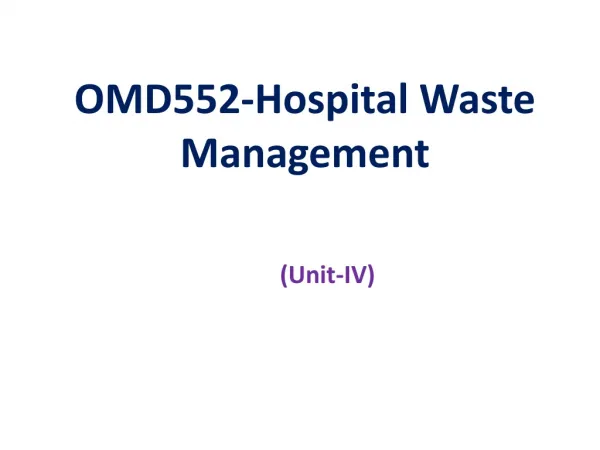
OMD552-Hospital Waste Management
OMD552-Hospital Waste Management. (Unit-IV). Syllabus ( UNIT IV-FACILITY SAFETY ). Introduction Facility Guidelines: Institute, Administrative Area Safety , Slip, Trip, and Fall Prevention, Safety Signs, Colors, and Marking Requirements, Tool Safety, Electrical Safety,
1.31k views • 14 slides

WASTE MANAGEMENT IN A PRIVATE HOSPITAL Dr.Shanta Nagarajan
INTRODUCTION . Anything not intended for use is waste All waste liquid solid generated by health care system are bio medical waste . . . In Delhi there are about 72 hospitals under Govt. sector ,550 registered nursing homes and 936 dispensaries.In addition to this there are about 1560 underegistered establishments with different names like Nursing homes,Medical Centres,Dental Hospitals,MTP centres etc.About 40000 hospital beds are available in the public
936 views • 32 slides
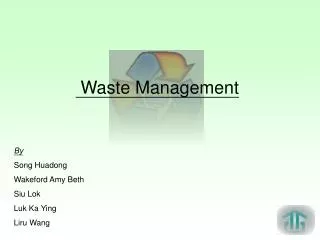
Waste Management
Waste Management. By Song Huadong Wakeford Amy Beth Siu Lok Luk Ka Ying Liru Wang. Sector – Waste. Reasons for choosing waste as our sector:. International Scale
1.47k views • 25 slides

HOSPITAL WASTE MANAGEMENT
OUTLINE. Potential Hazard of Hospital WasteWaste Management Sources of wasteClassification of Hospital WasteTreatment, Transport and Disposal MethodIncineration of Hospital WasteRegulations. Facts in Indonesia. RS mengolah Limbah = 53%, pengolahan dg IPAL dan septic tank = 51%, sisanya hany
1.56k views • 51 slides

Waste Management
Waste Management. Department of Fisheries and Aquatic Resources (DFAR) Sri Lanka. National Aquatic Resources Research and Development Agency (NARA) Sri Lanka. United Nations University Fisheries Training Programme (UNU-FTP) Iceland. Icelandic International Development Agency (ICEIDA)
1.67k views • 27 slides

Waste Waste Management
1.33k views • 17 slides

Waste Management
Waste Management. It is the collection , transportation, processing or disposal, managing and monitoring of waste materials. What is Waste Management?. Distinct practice from resource recovery which focuses on delaying the rate of consumption of natural resources. .
4.46k views • 16 slides

Waste Management
Waste Management . Obj - Discuss sources and types of waste. Waste Disposal. Solid waste disposal is a problem in this country It is considered by some to be the most pressing environmental problem . Solid Waste Sources . Solid waste: non-liquid, non-soluble materials
486 views • 10 slides

Waste Management Hazardous Waste
Waste Management Hazardous Waste. The topics of today. Rules and regulations Hazardous Waste Dangerous Goods Security advisement The work of SEKA Miljöteknik Laboratory waste Questions , comments , views and ideas. Askewed balance - Environmental changes. Organization.
1.09k views • 27 slides

Toxic , Hazardous and Hospital Waste Management
Toxic , Hazardous and Hospital Waste Management. Cheong, Jecilene Go, Kierson Nigel Hernandez, Airah Jane Razon , Jerica Marise. Hazardous Wastes. R.A. 6969.
3.2k views • 77 slides

Waste Management
Waste Management. External Supplier User Guide. SciQuest USA, Inc 5433 Westheimer Ste 925 Houston, TX 77056 1-800-233-1121. Table of Contents. Getting Started. 3
505 views • 19 slides
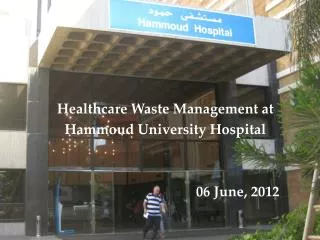
Healthcare Waste Management at Hammoud University Hospital
Healthcare Waste Management at Hammoud University Hospital. 06 June, 2012. Waste Management Plan. 1-Baseline Assessment. √. Onsite survey conducted at both model facilities. Policies and Procedures Update. 2-Waste Management Program. Organizational structure and resources’ allocation
718 views • 37 slides

Waste Management
Waste Management . Resource Conservation and Recovery Act 42 U.S.C. § 321 et seq. (1976). Waste Management and Pollution Control . Hierarchy of Waste Management Pollution Prevention Waste Reduction Recycle Treatment Disposal Pollution Prevention Act of 1990. Predecessor Laws.
882 views • 50 slides

Waste management
Waste management. Recycling :. - Running ou t of resources. - Less resources on production. Copenhagen Waste Management Plan - 2012.
232 views • 2 slides

Hospital Waste Bin
Hospital trash bin are available in a number of colors. These trash bins can hold different kinds of waste products like hospital wastes, hospital food wastes and hospital dirt. They help in carrying dirt and debris and maintain a clean environment.
408 views • 7 slides
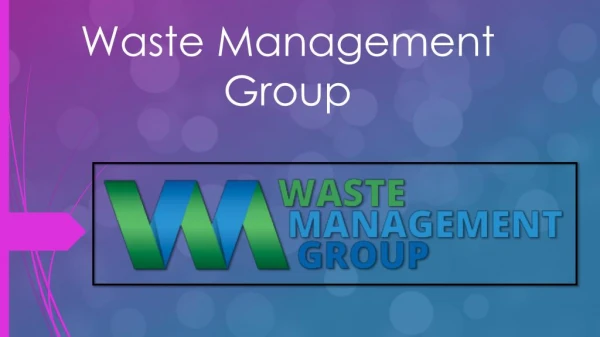
Waste Management Services-Waste Management Group
Waste Management Group are dedicated to finding alternative uses for all construction waste material. We care about our environment, and we are focused on becoming a market leader in the construction and demolition debris recycling industry. With Skip Bins and large volume Hook Bins for hire, and a centrally located Transfer Station in Molendinar, Waste Management Group provides a total waste and recycle service covering the Yatala to Northern Rivers. Professional and reliable, our services include prompt collection and recycle, or we accept and process commercial waste from waste collectors via our best guarantee tipping service.For More Info Check Our Website:-https://wmgroup.com.au
267 views • 9 slides

INJECTION SAFETY AND MANAGEMENT OF HOSPITAL WASTE
INJECTION SAFETY AND MANAGEMENT OF HOSPITAL WASTE. 1 Dr.I.A.Joshua 2 Dr JG Makama 3 Dr A Oyemecho 1 Department of Community/ 2 Department of Surgery Kaduna State University, Kaduna, Nigeria 3 Department of Epidemiology and Community Health, Benue State University, Makurdi, Nigeria.
407 views • 22 slides

Waste Management
Waste Management. Clark County School District Laboratory and Chemical Waste Storage Area Safety Training. Waste Regulations. 1976, Resource Conservation and Recovery Act (RCRA)
388 views • 31 slides

Waste Management
Waste Management. Environment. Water Organic Matter Plant Nutrients Salt. Water Food Air Energy. Environment. Manure components may be positives or pollutants. Manure components may be positives or pollutants …. It all depends on how and when they reenter the environment.
876 views • 71 slides
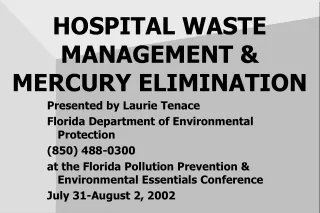
HOSPITAL WASTE MANAGEMENT & MERCURY ELIMINATION
HOSPITAL WASTE MANAGEMENT & MERCURY ELIMINATION. Presented by Laurie Tenace Florida Department of Environmental Protection (850) 488-0300 at the Florida Pollution Prevention & Environmental Essentials Conference July 31-August 2, 2002. HOSPITALS FOR A HEALTHY ENVIRONMENT. Working Together
437 views • 33 slides






















